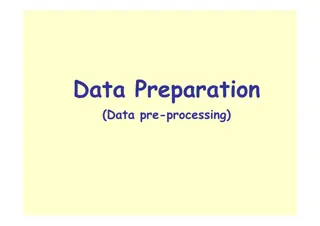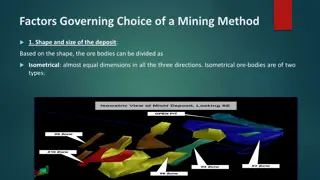Developing Agricultural Simulation System Using Data Mining Techniques
Development of an agricultural simulation system involves identifying data sources, collecting and integrating data, preprocessing, applying data mining techniques, developing simulation models, calibration, validation, and optimization for performance. User interface development and deployment are crucial for stakeholders' use and ongoing maintenance.
Uploaded on Aug 13, 2024 | 2 Views
Download Presentation

Please find below an Image/Link to download the presentation.
The content on the website is provided AS IS for your information and personal use only. It may not be sold, licensed, or shared on other websites without obtaining consent from the author.If you encounter any issues during the download, it is possible that the publisher has removed the file from their server.
You are allowed to download the files provided on this website for personal or commercial use, subject to the condition that they are used lawfully. All files are the property of their respective owners.
The content on the website is provided AS IS for your information and personal use only. It may not be sold, licensed, or shared on other websites without obtaining consent from the author.
E N D
Presentation Transcript
Lecture 26: Open technology computing facilities, System for data analytics/ mining/ modelling/ simulations Development of Agricultural Centurion University of Technology and Management, Odisha, India
Developing a system for data mining and the development of agricultural simulations involves several steps and considerations. Identify Data Sources: Determine the data sources that will be used for the agricultural simulations. This may include weather data, soil data, crop yield data, satellite imagery, pest and disease data, and other relevant datasets. Identify reliable and comprehensive sources to ensure the accuracy and relevance of the simulations. Data Collection and Integration: Collect the necessary data from the identified sources and integrate it into a central database or data repository. This may involve data cleaning, formatting, and standardization to ensure consistency and compatibility across different datasets. Data Preprocessing: Perform preprocessing steps on the collected data to prepare it for data mining and simulation development. This includes tasks such as data normalization, outlier detection, missing data handling, and feature selection or extraction. Data Mining Techniques: Apply appropriate data mining techniques to analyze the collected data and extract meaningful patterns, relationships, and insights. Common data mining techniques used in agriculture include classification, clustering, association rule mining, regression analysis, and time series analysis. Centurion University of Technology and Management, Odisha, India
Simulation Model Development: Based on the insights gained from the data mining process, develop simulation models that mimic real-world agricultural processes and systems. These models can range from simple mathematical models to complex agent-based simulations. Consider factors such as crop growth, climate conditions, soil fertility, irrigation, pest management, and market dynamics when designing the simulation models. Calibration and Validation: Using real-world data and observations, Calibrate and validate the developed simulation models. This involves comparing the simulation outputs with actual field data to ensure the accuracy and reliability of the models. Adjust the model parameters and assumptions as needed to improve the model's performance. User Interface and Visualization: Develop a user-friendly interface and visualization components for the agricultural simulation system. This allows users to interact with the simulation models, input different scenarios, and visualize the simulation results. The interface should provide intuitive controls and meaningful visualizations to facilitate user understanding and decision-making. Centurion University of Technology and Management, Odisha, India
Performance Optimization: Optimize the performance of the simulation system to ensure efficient computation and responsiveness. This may involve techniques such as parallel processing, caching, or optimization algorithms, depending on the complexity and scale of the simulations. Testing and Validation: Thoroughly test the entire system for functionality, usability, and performance. Conduct rigorous testing to identify and fix any bugs, errors, or inconsistencies. Validate the simulation outputs against real-world data to ensure the accuracy and reliability of the system. Deployment and Maintenance: Once the system is tested and validated, deploy it for use by agricultural stakeholders. Provide ongoing maintenance and support to address any issues, update data sources, refine simulation models, and incorporate new features or improvements as needed. Centurion University of Technology and Management, Odisha, India























